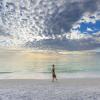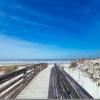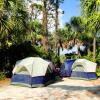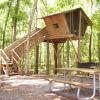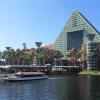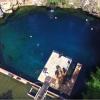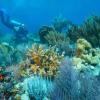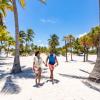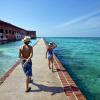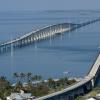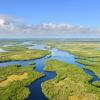Try diving near Key Biscayne, where you'll discover a nearby coastal barrier reef
Greater Miami Convention & Visitors Bureau
The Key Biscayne coastline; Big-city Miami stands in the background
Greater Miami Convention & Visitors Bureau
A trip to the Miami area isn’t complete without a stop in South Beach. Now, add Key Biscayne to the list of must-sees while in the area. From sunny beaches to the Ritz-Carlton, Key Biscayne offers all the allure of south Florida on a tiny sliver of land.
Most visitors to the Miami area head directly to South Beach, famous for its great beach and nonstop nightlife. But if they limit their travels to that Art Deco hot spot, visitors will miss one of the America’s most storied retreats, Key Biscayne.
A short drive from South Beach, Key Biscayne activities include great beaches and the added appeal of being sandwiched between two major parks – Crandon Park to the north and Bill Baggs Cape Florida State Park to the south. A nearby coastal barrier reef and the only federally recognized underwater archaeological trail in the United States are marjor draws for people looking for what to do in Key Biscayne.
Virginia Key First
On the way to Key Biscayne, Virginia Key’s two main attractions still thrive. The 38-acre Miami Seaquarium is the home of TV’s Flipper, dolphin swims and marine animal shows.
Historic Virginia Key Beach Park is on the National Register of Historic Places for its place in history as the only beach in Miami-Dade County that African-Americans could visit during segregation. The city of Miami has restored a 15-acre hammock area, including removing invasive exotic vegetation and restoring native plants. While officials have more extensive plans for the area, today visitors can walk on the Virginia Key Coastal Hammock Interpretive Trail.
Key Biscayne was first settled by the Tequesta Indians, then “discovered” in 1513 by the Spanish explorer Juan Ponce de Leon.
Today, visitors staying at the 12-acre Ritz-Carlton Key Biscayne, Miami complex or visiting from the Miami-Dade County region can get a glimpse of the natural beauty the early settlers saw by exploring either of the island’s parks.
Key Biscayne Activities: Parks, Tours & History
Miami-Dade County’s parks department promotes the area’s history with an assortment of tours, including Key Biscayne Heritage Bike Trips.
These trips, part of Miami Parks and Recreation’s EcoAdventures program, take in the island’s subtropical natural history at Bear Cut Marine Preserve and Crandon Beach. These trips also explore the social history of the island.
The island has a great story to tell visitors. In the 1930s, most of Key Biscayne belonged to New York industrialist William John Matheson. It was Matheson (persuaded by Charles Crandon, a county commissioner who oversaw the public parks system) who, in 1940, donated the 800 acres that is now Crandon Park in exchange for the county’s commitment to build a causeway.
EcoAdventures offers a wide program of tours at Crandon. During the summer turtle season, there are nightly presentations and a hatchling release program. EcoAdventures offers sea kayak and snorkel adventures on Biscayne Bay year round. The snorkel part of the trip highlights the bay’s petrified mangrove reefs. Through the year, a Key Biscayne Sunset Boat Cruise lets paddlers watch the sun set over Biscayne Bay.
Like the rest of Key Biscayne activities, Crandon Park appeals to those who like cities, beaches and nature. The two miles of Crandon Park Beach have full lifeguard service, concession stands, bathing facilities and beach cabanas. Crandon Park also offers tram trips, golf, tennis and a marina.
Experiencing nature is on everyone's list of what to do in Key Biscayne. At Crandon, nature tourism opportunities are abundant, including native plant tours (look for the native Biscayne prickly ash). Visitors can experience natural tropical beauty, rich history and abundant wildlife on Miami-Dade County Parks’ Eco AdventureTM Tours from the Crandon Park Visitor and Nature Center. The tours take visitors to dunes, mangroves, coastal hammocks and sea-grass beds, where they can observe herons, ospreys and many brilliantly colored butterflies. For more information about EcoAdventuresTM Tours call 305-365-3018, or visit their website at www.miamidade.gov/ecoadventures.
Also at the park are the Crandon Park Beach Gardens. The gardens are remnants of Zoo Miami, which moved from Key Biscayne in 1962. A group of volunteers later took over the site and restored the remaining gardens, including lakes and forests.
At the park (and also a remnant of the zoo era) is the historic 1950s Allen Herschell carousel at Crandon Park Beach Amusement Area (South Beach Entrance). It offers rides to children and their families at a cost of $2 for three rides. The carousel is open 10 a.m. - 4:30 p.m. on Saturdays, Sundays and holidays..
Concerned about overdevelopment of the island’s southern tip, Bill Baggs, a local newspaper editor, was successful in the 1960s in organizing a grassroots movement to create a park on Key Biscayne. The Bill Baggs State Recreation Area is a rustic park filled with boardwalks and nature trails where visitors can rent kayaks. Eighteen covered pavilions provide shaded picnicking overlooking the Atlantic Ocean and Biscayne Bay.
The jewel of the park is the 1825 Cape Florida lighthouse, rebuilt in 1846 after it was burned by Native Americans during the Seminole war. Today, visitors can climb its 109 steps during twice-daily tours for a panoramic view of Miami and Biscayne Bay.
The lighthouse isn’t the only thing historic about the park. Cape Florida was a secret meeting place and port for runaway slaves who were escaping the United States. To honor this history, the National Park Service designated Cape Florida as a National Underground Railroad Network to Freedom Site.
Nixon Arrives
Named after the developer who built them, these modest Florida slab houses were uniformly 1,200 square feet and about $10,000. Although many have since been replaced by fancier digs because of property values, the remaining ones can be spotted by visitors because of their low-pitched roofs.
Key Biscayne was the site of that famous meeting between Richard Nixon and John F. Kennedy after Kennedy beat Nixon in the 1960 election. Nixon later bought a simple, concrete, one-story house in the area in 1969. It was the first of three waterfront houses that together would become the compound dubbed the Winter White House.
In the shadow of busy Miami, Key Biscayne remains a world unto itself. Golf carts and bicycles cause the only traffic jams. The parks and beaches are stunning (Cape Florida has been ranked among America’s top beaches by geologist “Dr. Beach,” Stephen Leatherman). The Key Biscayne Heritage Trail offers views of bicyclists and runners crisscrossing the island, surfers visible offshore and an occasional cruise ship passing in the distance.
What to do in Key Biscayne
Catch the sunset and great city views at the Rusty Pelican, which just reopened after a renovation and is re-emerging as a buzzing, contemporary hot spot (3201 Rickenbacker Causeway; 305-361-3818). Locals find Cuban food at La Carreta, 12 Crandon Blvd., 305-365-1177.
There are two hotels on the island. There is the Ritz–Carlton Key Biscayne, Miami (455 Grand Bay Drive, 305-365-4500) and the Silver Sands Beach Resort, an old-fashioned cabana-style motel with kitchenettes (301 Ocean Drive, 305-361-5441). Find more information at KeyBiscayneChamber.org.
Heritage bicycle tours, kayaking and snorkeling are run by Miami-Dade County EcoAdventures. Call 305-365-3018, go to www.miamiecoadventures.com to see a video on the offerings, or email ECOAdventures@miamidade.gov.
Stop at Marjory Stoneman Douglas Biscayne Nature Center, offering hands-on marine exploration among dunes, beaches, coastal hammocks, and fossil-rock reefs, Key Biscayne’s own underwater petrified forest (4000 Crandon Blvd., 305-361-6767).
Looking to take part in some more traditional Florida sports? Play tennis at the Crandon Park Tennis Center (6767 Crandon Blvd., 305-365-2300). Or enjoy a round of golf at Crandon Park. Its sculpted fairways rank it among the top 50 public courses in Florida (6700 Crandon Blvd., 305-361-9129).
